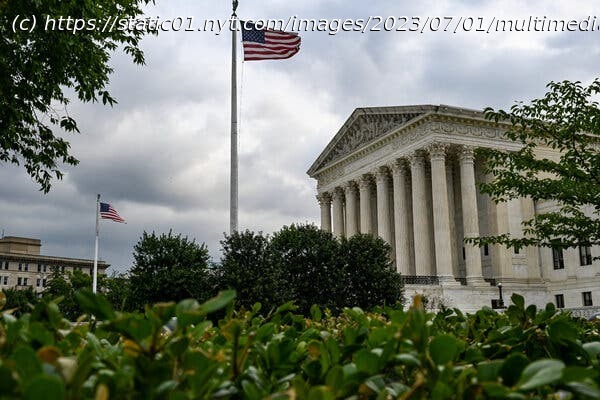Chief Justice Roberts delivered both landmark victories for the right and significant rulings in which he forged alliances with the liberal justices.
The Supreme Court ended its term this week in familiar fashion, issuing blockbuster conservative decisions on affirmative action, gay rights and student loans that divided along partisan lines, with the court’s three Democratic appointees in dissent.
While not quite as stunning as last June’s decisions eliminating the right to abortion and expanding gun rights, the new rulings were of a piece with them and were a further indication that the court remains receptive to the conservative legal movement’s agenda, including cutting back on a progressive conception of civil rights and frustrating President Biden’s initiatives.
But the entire story of the most recent term is considerably more complicated than that of the previous one, which had seemed to establish an unyielding conservative juggernaut characterized by impatience and ambition — and built to last.
A year later, the court remains deeply conservative but is more in tune with the fitfully incremental approach of Chief Justice John G. Roberts Jr., who is attentive to his court’s legitimacy, than with the take-no-prisoners approach of Justice Clarence Thomas. The chief justice’s strategy — and votes — produced a fair number of liberal victories.
“Chief Justice Roberts seems to be getting at least some of the conservative majority back into harness on incremental moves,” said Pamela S. Karlan, a law professor at Stanford.
Indeed, the term that just ended was something of a triumph for the chief justice, who just a year ago seemed to be losing power, having failed to persuade a single colleague to join his compromise position in the case that did away with the constitutional right to abortion.
“Those tables have dramatically turned,” Professor Lazarus said. “Although the chief justice has struggled mightily under rising public expectations to address ethical issues within the court, mostly focused on Justice Thomas, the chief rather than Thomas remains the most influential justice on the court in terms of the outcomes in the court’s opinions.”
Indeed, Chief Justice Roberts was in the majority in divided cases decided by signed opinions 86 percent of the time, second only to Justice Brett M. Kavanaugh, at 90 percent. Justice Thomas was last by this measure, at 55 percent.
Thanks largely to alliances with Chief Justice Roberts and one or more of President Donald J. Trump’s three appointees — Justices Kavanaugh, Neil M. Gorsuch and Amy Coney Barrett — the court’s three liberals were in the majority in a considerable number of important cases. They included ones on the Voting Rights Act, immigration, the role of state legislatures in elections and Native American rights.
The three liberals were on the winning side more often than the court’s two most conservative members, Justices Thomas and Samuel A. Alito Jr.
“Looking across the entire docket — not just the term’s last two days — the data show a shift from the most conservative and aggressive court in modern history to one that has moderated,” said Lee Epstein, a law professor and political scientist at the University of Southern California.
Home
United States
USA — Political Along With Conservative Triumphs, Signs of New Caution at Supreme Court






